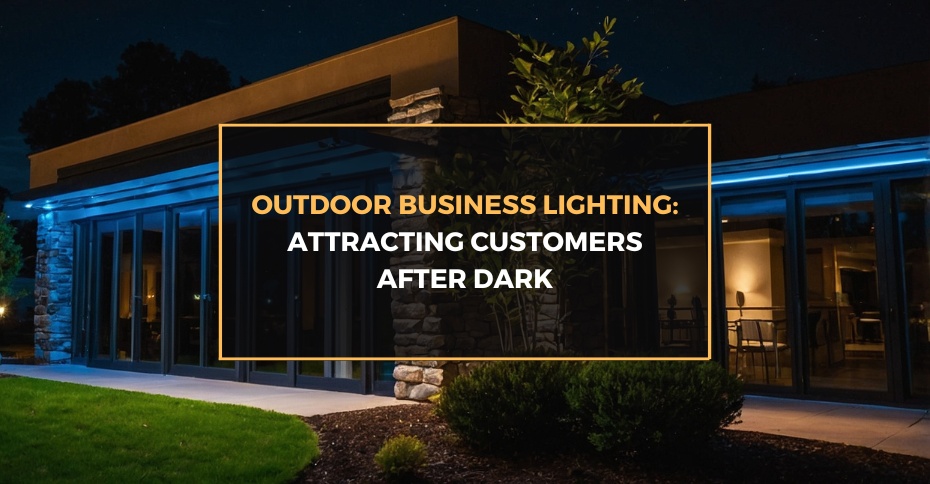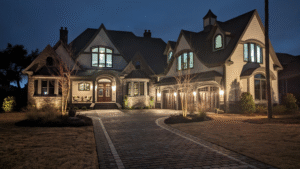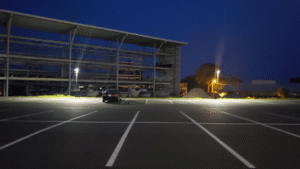Why Outdoor Lighting Matters for Your Business
Enhancing Curb Appeal and Visibility
Outdoor business lighting plays a crucial role in making a business stand out after dark. It increases the visibility of the property, making it easier for potential customers to locate and identify the business, especially in areas with high foot traffic or along busy streets. Bright, well-placed lighting can highlight the architectural features of a building, making it more appealing to passersby. This visibility is key in drawing in customers who might not have noticed the business otherwise, particularly during evening hours.
Creating a Safe and Welcoming Environment
Outdoor lighting significantly contributes to the safety of both customers and employees. Adequate lighting in parking lots, walkways, and entrances helps prevent accidents and deters criminal activity. A well-lit business environment creates a sense of security, encouraging customers to visit even after dark. This sense of safety is essential for businesses such as restaurants, retail stores, and service providers that operate during evening hours.
Extending Operating Hours and Business Opportunities
Outdoor business lighting enables businesses to extend their operating hours by attracting customers even after the sun has set. This is particularly beneficial for establishments like cafes, restaurants, and entertainment venues that thrive on evening patronage. By creating an inviting atmosphere with effective lighting, businesses can maximize their potential revenue and serve a broader customer base. This extended presence not only boosts sales but also strengthens the business’s brand in the community.
Types of Outdoor Lighting to Consider
Accent Lighting for Highlighting Architectural Features
Accent lighting is used to draw attention to the unique architectural elements of a business, such as columns, facades, and landscaping. This type of lighting can be strategically placed to create a dramatic effect, making the building more visually appealing. In addition to improving aesthetics, accent lighting can help a business stand out from its neighbors, making it more memorable to customers. It also enhances the overall look of the property, reflecting positively on the business’s image.
Pathway Lighting for Safe Navigation
Pathway lighting is essential for guiding customers safely to and from the entrance of a business. It illuminates walkways, stairs, and parking areas, reducing the risk of trips and falls. This type of lighting is particularly important in areas with uneven terrain or poor visibility. Businesses can use pathway lighting not only for safety but also to create a welcoming environment. By choosing attractive fixtures, businesses can enhance the overall aesthetic appeal of their outdoor spaces.
Floodlights for Enhanced Security
Floodlights provide broad, powerful illumination, making them ideal for security purposes. They can cover large areas such as parking lots and loading zones, deterring potential intruders and improving visibility for security cameras. Businesses can install floodlights with motion sensors to save energy and only activate the lights when movement is detected. This feature is particularly effective for reducing energy costs while maintaining a high level of security.
Signage Lighting to Boost Brand Recognition
Signage lighting ensures that business signs are visible and legible at all hours, enhancing brand recognition. Illuminated signs can attract attention from a distance, making it easier for customers to locate the business, even in low-light conditions. Businesses can choose from various signage lighting options, including backlit, front-lit, and halo-lit styles, depending on their branding needs. Effective signage lighting not only improves visibility but also strengthens the overall marketing efforts of the business.
Designing an Effective Outdoor Lighting Plan
Assessing Your Business’s Lighting Needs
Every business has unique lighting requirements based on its location, hours of operation, and customer base. Conducting a thorough assessment of these needs is the first step in creating an effective outdoor lighting plan. Businesses should consider factors such as the surrounding environment, potential hazards, and the specific areas that require illumination. Understanding these needs will help in choosing the right types of lighting fixtures and designing a layout that maximizes both safety and aesthetics.
Choosing the Right Fixtures and Placement
The choice of fixtures and their placement are critical to achieving the desired effect with outdoor business lighting. Different fixtures serve different purposes, such as spotlighting, ambient lighting, or security. Proper placement ensures that the lighting is effective without causing glare or light pollution. Businesses should also consider the durability and maintenance needs of the fixtures, as outdoor lighting is exposed to various weather conditions. Investing in high-quality, weather-resistant fixtures can reduce long-term costs and maintenance efforts.
Balancing Aesthetics and Functionality
While aesthetics play a significant role in outdoor lighting, functionality should not be compromised. Businesses need to find a balance between creating an attractive atmosphere and providing sufficient illumination for safety and security. This balance can be achieved by using a combination of different lighting types, such as accent lights for visual appeal and floodlights for security. Properly designed lighting not only enhances the look of the business but also improves the overall customer experience.
Tips for Attracting Customers with Outdoor Lighting
Using Color and Brightness to Create Ambience
The color and brightness of outdoor lighting can significantly impact the ambiance of a business. Warm, soft lighting can create a cozy, inviting atmosphere for restaurants and cafes, while bright, cool lighting may be more appropriate for retail stores looking to attract attention. Businesses can experiment with different color temperatures and intensities to find the right balance that suits their brand and target audience. Dynamic lighting options, such as color-changing LEDs, can be used for special events or promotions to draw in more customers.
Seasonal and Event Lighting Ideas
Seasonal lighting, such as holiday decorations or event-specific themes, can make a business more attractive and engaging. Businesses can use string lights, lanterns, or themed fixtures to create a festive atmosphere that encourages customers to visit. Event lighting can be used to celebrate occasions like grand openings, product launches, or community events, making the business a focal point in the area. Such lighting displays can enhance customer engagement and create memorable experiences.
Utilizing Smart Lighting Technology for Dynamic Displays
Smart lighting technology offers businesses the flexibility to create dynamic lighting displays that can be adjusted remotely. With programmable features, businesses can change the color, intensity, and timing of their lights to suit different events or times of the day. This technology can also integrate with other smart systems, such as security cameras and sensors, to optimize energy use and improve security. Smart lighting not only enhances the visual appeal but also provides practical benefits like energy savings and reduced maintenance.
Energy-Efficient Outdoor Lighting Options
Benefits of LED Lighting for Businesses
LED lighting is a popular choice for outdoor business lighting due to its energy efficiency and longevity. LEDs use significantly less energy compared to traditional incandescent or halogen bulbs, resulting in lower utility bills. They also have a longer lifespan, reducing the need for frequent replacements and maintenance. Businesses can benefit from the wide range of LED options available, including dimmable and color-changing models, which offer versatility for different lighting needs.
Solar-Powered Lighting Solutions
Solar-powered lighting is an eco-friendly option that utilizes renewable energy to illuminate outdoor spaces. These lights are equipped with solar panels that charge during the day and provide illumination at night, eliminating the need for electrical wiring. Solar lighting is particularly useful for areas that are difficult to reach with traditional power sources. Businesses can use solar-powered path lights, spotlights, and even signage lights to reduce their environmental impact and energy costs.
Motion Sensors and Timers for Reduced Energy Costs
Installing motion sensors and timers is an effective way to manage outdoor lighting and reduce energy consumption. Motion sensors activate lights only when movement is detected, making them ideal for security purposes without wasting energy. Timers can be set to turn lights on and off at specific times, ensuring that lights are not left on unnecessarily. These features help businesses save on energy costs while maintaining adequate lighting for safety and security.
Maintenance and Safety Considerations
Regular Inspection and Cleaning Tips
Maintaining outdoor business lighting is essential to ensure optimal performance and longevity. Regular inspections can help identify issues such as burned-out bulbs, damaged fixtures, or faulty wiring. Cleaning the fixtures periodically prevents the buildup of dirt and debris, which can reduce the brightness and effectiveness of the lights. Businesses should establish a maintenance schedule that includes checking all components of the lighting system to ensure everything is functioning properly.
Ensuring Compliance with Local Lighting Regulations
Outdoor lighting is often subject to local regulations that dictate the types, brightness, and placement of fixtures. Businesses need to be aware of these rules to avoid penalties and ensure that their lighting is compliant. Regulations may include restrictions on light pollution, glare, and the impact on nearby residential areas. Consulting with a lighting professional or local authority can help businesses design a lighting plan that meets all legal requirements.
Preventing Light Pollution and Glare
Light pollution and glare can have a negative impact on the surrounding environment and the business itself. To prevent these issues, businesses should use fixtures that direct light only where it is needed, avoiding excessive brightness or spillage. Using shields or baffles can help control the direction of light and reduce glare. Properly designed lighting not only enhances the look of the business but also minimizes the impact on neighboring properties and the environment.
Conclusion: Maximizing the Impact of Outdoor Business Lighting
Key Takeaways for Business Owners
Outdoor business lighting is a powerful tool for enhancing visibility, safety, and customer experience. Businesses should carefully plan their lighting strategy, choosing fixtures and placements that align with their brand and customer needs. Investing in energy-efficient options and smart technology can reduce costs and improve the effectiveness of lighting. Regular maintenance and compliance with regulations ensure that the lighting system remains functional and beneficial in the long term.
Next Steps: Implementing Your Lighting Plan
After assessing their needs and designing a lighting plan, businesses should consider professional installation to ensure proper setup. Working with a lighting expert can help address any challenges and ensure that the system is optimized for performance and compliance. Once the lighting is installed, businesses should monitor its impact and make adjustments as needed to maximize its effectiveness. Implementing a well-thought-out outdoor lighting plan can significantly boost a business’s presence and customer appeal after dark.
Frequently Asked Questions (FAQs)
-
What is the best type of lighting for business signs?
The best type of lighting for business signs depends on visibility and branding needs. LED backlit signs are popular for their brightness and energy efficiency. Front-lit or halo-lit options provide a sophisticated look and can enhance the overall visibility of the sign.
-
How can I make my outdoor lighting more energy-efficient?
Using LED fixtures, installing solar-powered lights, and incorporating motion sensors and timers can significantly reduce energy consumption. Opting for energy-efficient bulbs and maintaining the lighting system regularly also helps in minimizing energy use.
-
Are there any legal restrictions on outdoor business lighting?
Yes, local regulations often dictate the brightness, placement, and type of outdoor lighting to prevent issues like light pollution and glare. Businesses should consult with local authorities or a lighting professional to ensure compliance with these regulations.
-
How often should I maintain my outdoor lighting system?
Regular maintenance is recommended every six months, or more frequently if the lighting system is exposed to harsh weather conditions. Maintenance should include inspecting for damage, cleaning fixtures, and checking for any electrical issues to ensure optimal performance.






